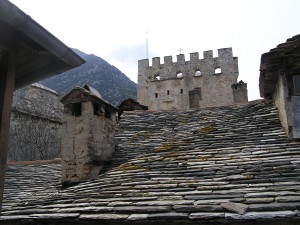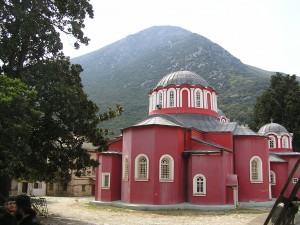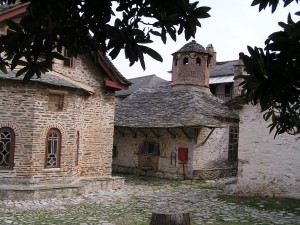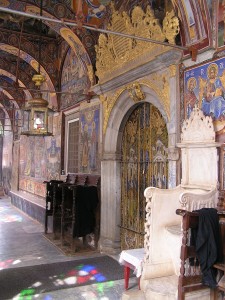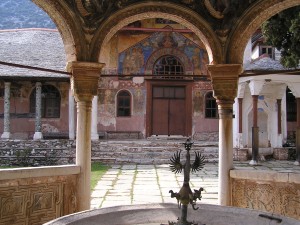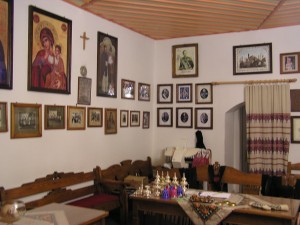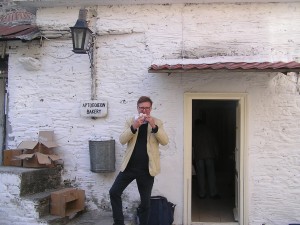The imperial double-headed eagle still flies over Mount Athos. The peninsula, in northern Greece, has been a self-governing monastic republic for over a thousand years. Robert Byron described it as ‘the composite and living memorial of a great civilisation’, for timeless Mount Athos represents the last gasp of the Byzantine Empire.
Constantinople fell to the Ottoman Turks in 1453, but the Holy Mountain continues to be regulated by a charter of the Emperor Constantine IX Monomachos. It was the Emperor Monomachos, the direct heir to Augustus and Constantine the Great, who in 1045 confirmed the legal immunity of the Holy Mountain, and famously banned all female creatures from the peninsula, along with eunuchs and beardless boys.
To the consternation of female scholars and feminists, that prohibition still applies. However, having visited Mount Athos twice I am able to confirm the presence there of hens, she-cats, young boys and, indeed, beardless monks – and that it is only one’s passport and diamonitirion (official permit) that are examined at the port of entry.
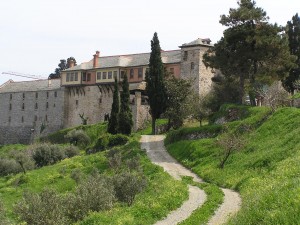 The oldest, largest and remotest of the twenty surviving monasteries on Mount Athos is the ‘Great Holy Monastery of the Greatest Lavra’. It was founded in 963 by St Athanasios of Trebizond, whose earlier career had been as a teacher in Constantinople. Athanasios had served his noviciate, in a hermitage on Bithynian Mount Olympos, with the future Emperor Nikephoros Phokas (a thwarted-monk-turned-soldier who was known to his trembling enemies as ‘the White Death of the Saracens’), through whose offices the new monastery was richly endowed, not only with lands and privileges, but also with holy relics from the imperial collection.
The oldest, largest and remotest of the twenty surviving monasteries on Mount Athos is the ‘Great Holy Monastery of the Greatest Lavra’. It was founded in 963 by St Athanasios of Trebizond, whose earlier career had been as a teacher in Constantinople. Athanasios had served his noviciate, in a hermitage on Bithynian Mount Olympos, with the future Emperor Nikephoros Phokas (a thwarted-monk-turned-soldier who was known to his trembling enemies as ‘the White Death of the Saracens’), through whose offices the new monastery was richly endowed, not only with lands and privileges, but also with holy relics from the imperial collection.
Athanasios’s monastery, or lavra, was the first on the Holy Mountain. The very concept of a monastery was frowned upon by the true ascetics – even today there are hermits living there in caves on the sides of cliffs, spiritual athletes who are often driven to madness by their solitude – but Athanasios had ‘found by experience that it is right and beneficial for brothers to live together’.
The Greatest Lavra resembles a castle with its great battlemented walls and keep, the so-called Tower of Tzimiskes. A necessary defence against pirates, who were long a blight on the place, these enclose a complex of buildings and courtyards, covering three or four acres, and date from the time of Athanasios himself.
Lavra was the template for all the subsequent monasteries on Mount Athos and, despite the intrusion of ugly and oversized buildings from later periods, the core structures from Athanasios’s time are still intact: the mulberry-coloured katholikon or church at its heart, the trapeza or refectory opposite, and, in between, the domed phiale or fountain, still the largest on Mount Athos.
Settling in and off to Church
We found our way to the archontiriki (guest-house), which is set into the walls above the main entrance. On a broad, covered balcony, crowded with visiting monks, we were received by a courteous and efficient lay helper. We entered the required particulars, including the names of our fathers, in the register.
Our attentive host returned with raki, Turkish coffee and glasses of water. He advised us that the service at 5 would be followed by a meal in the trapeza, and that the gates of the monastery would be closed at 8. We were shown to our room, one of four large dormitories that overhung the walls, each containing about fifteen beds, but neat and clean, with large windows looking down to the sea.
Lavra has a captivatingly timeless atmosphere, despite the hideous modern additions. The most egregious of these is the large helipad outside, done in red asphalt with a large letter ‘H’ in the middle. It seemed to contradict the very purpose of the monastery as a place of extreme seclusion. Perhaps the rot had already set in a thousand years ago, the early monks seeming reluctant to sever all links with the outside world: the hermits who inhabited the neighbourhood had criticised them for keeping their own boat.
The rambling kitchen block, on the other hand, seemed to be a very ancient structure, barely changed in centuries, and there were numerous dark passages, staircases and ramparts to explore.
We observed the service as best we could, propped against the stalls, from the narthex of the katholikon, for the non-Orthodox are not admitted to the body of the church. The Greek services are long and baffling with occasional dramatic interludes – the lighting and snuffing of candles, the swinging of the corona, the censing of the congregation, who otherwise play no part. Music, other than singing, is forbidden. It is important to stand when required and to maintain a respectful posture.
The Trapeza
We were unprepared for the splendour of the trapeza, into which we processed at last for supper. A huge room in the shape of a cross, it was frescoed from top to bottom by the sixteenth-century master Theophanes of Crete, with numerous depictions of the saints and of biblical episodes, including the Day of Judgement. It has a stone-flagged floor and a simple wooden ceiling, cheerfully painted.
Most remarkable are the horseshoe-shaped tables and seats, which are set in stone along the length of the room. The stone base of each has been plastered over and whitewashed. The seats have boards laid on top of them and fastened down, while great grey marble slabs serve as table tops, some with little channels at the rim. Here, as was customary, we ate in silence, while some improving text was read to us from the far end of the room.
The food was delicious – a thick reddish broth, filled with rice, of indeterminate flavour (perhaps red cabbage), with Coquilles de St Jacques, boiled eggs painted red for Easter, bread, plenty of red wine and oranges. When the meal was over, we filed past a row of monks, those in charge of the kitchen, who had their heads bowed, graciously but needlessly assuming postures of penitence for their unworthy fare.
We stole back in for a closer examination of the trapeza, and were saddened to witness the deterioration of the frescoes. According to my companion, this was caused by rising moisture, the stone-flagged floors being about three feet below the ground level outside.
I congratulated an attendant (a Romanian who spoke good English) on the excellent supper, and asked for the ingredients. He would not, or could not tell me, and laughed at my suggestion that the recipe was perhaps a secret.
A grumpy monk, and a kindly one
A few minutes later we were waved back into church for a further service. We assumed our usual positions in the narthex, but discovered that much of the proceedings was to be conducted from thence – an intoning by half a dozen monks, positioned in opposite corners, of various texts, while the rest of the congregation and monks were otherwise engaged in the body of the church, from which we were separated by a curtain.
We had noticed the desultory manner in which the offices were read, but were surprised when, soon into the service, we were engaged in conversation by an elderly monk, though to all outward appearances we were deep in contemplation or prayer. The fellow enquired curtly, in a loud, gruff voice, whether we were German. We satisfied him that we were not. His suspicions were, nevertheless, aroused. Where we, perhaps, Roman Catholic?
I had instructed my amiable companion, an old Amplefordian, to deny his Catholicity for the sake of a quiet life. (The Pope and all his cohorts have never been forgiven for the sack of Constantinople in 1204.) For about the fifth time in three days, Hamish dutifully declared himself an Anglican.
The surly fellow had been a monk of Lavra for twenty years. He explained that he had known England well, from visits to his sisters in Barry, near Cardiff. Did we know Barry? Hamish claimed, most unconvincingly, to have ‘driven through it’.
He then asked us what we did. ‘I am a writer,’ I said.
‘What do you write?’
‘History.’
‘Why do you bother?’ he said. ‘All history has been written.’
‘There are always new ways of looking at things,’ I stammered.
‘But the past is απολυτος,’ he said. ‘Fixed, unchangeable.’ I reflected wistfully on my modest corpus of work, even of Basingstoke and its Contribution to World Culture, my tragi-comic account of a typical English town, seminal in its way. Yet worse was in store for Hamish.
‘I am an I.T. consultant,’ he announced. ‘To do with computers,’ he added, helpfully.
‘Aagh!’ said our friend, with an expression of disgust. ‘The computer is the μηχανισμος του Σατανου – machinery of Satan.’ Before Hamish could defend himself, the gruff monk, fully confirmed in his belief that we were incorrigible heretics, had walked away.
At the end of the service, the other congregants pressed forward for the purpose of examining the holy relics. A younger, more kindly monk encouraged us to join them. We took the opportunity to examine the frescoes, which are also attributed to Theophanes. Those in the narthex, of which we had had our fill, were inferior nineteenth-century work.
The kindly monk knew all about the buildings and their history. He pointed out the portraits of Nikephoros Phokas and of his nephew John Tzimiskes, who murdered him and took his throne. The two men seem to glare at each other across the doorway. The defensive Tower, named after the Emperor Tzimiskes, can only be entered through the monks’ own quarters. It contains four floors, but is not used. We learnt that the sakkos (embroidered vestment) and crown of Nikephoros Phokas, which I was most curious to see, could not be viewed as they were locked away, with all the other contents of the library. A new library is being built to house them. The noise and clutter of the construction work were all around us.
The kindly monk showed us Athanasios’s tomb in a side chapel. I asked why Athanasios’s death in this very building, from falling masonry, was not thought to be a sign of divine displeasure. He explained that Athanasios had evidently been ready for his reception into Heaven, having dressed appropriately for the occasion. The saint’s body was miraculously preserved and was partly visible in its silver casing. We were shown the iron rod, propped against the adjacent wall, with which the saint had performed one of his miracles, smashing open a rock so that it flowed with water.
The kindly monk had to hurry away, but we were grateful indeed that he had been so generous with his time.
The new library
We took a closer look at the construction work. With its concrete frame, basement and lift shaft, the new library looked like being another unnecessary modern intrusion.
Was it really worth the disruption and expense? Could they not have renovated an existing building? The monastery possesses an invaluable collection of charters, but these have been comprehensively edited and published by Madame Rouillard and her collaborators in their Actes de Lavra. Though it would have greatly gratified my curiosity to have had a sight of the originals, I had no pressing need to do so, and wondered how many scholars could be expected to make use of such a library at any one time. Even Madame Rouillard (a proscribed woman) had relied on photographs that were taken in 1918.
Besides, entry to Athonite libraries is hardly encouraged. In the seven monasteries on the peninsula that I have visited, I have only ever been admitted to one library, that at Gregoriou, which was represented to me as an exceptional privilege.
Back at the Archontiriki
The monastery proclaims its deep conservatism in the Guests’ Common Room. The room is stark and dimly lit, with a central chandelier, but the walls are crowded with pictures. A series of crude, colourful prints commemorates the heroes of the War of Independence. There are group photographs of the monks, with their lay servants and attendant evzones, dating from the 1920s and 30s; a couple of oil paintings of sailing ships apparently floundering off the peninsula; and, arrestingly, a set of portraits of the former kings of Greece, including the last, a young Constantine in black and white. Asked what his countrymen might make of that, a fellow pilgrim, a Greek, thought that they would be ‘disappointed’.
We retreated at last to our dormitory, where most of our room-mates were already preparing for, or in bed. I had a cold shower in the bathroom downstairs, but am British, so that was all right. We had a disturbed night, as one of the Russian pilgrims snored incessantly like a walrus, reducing us at first to giggles. I awoke to the put-put of a motor-scooter being started up, but this turned out to be our snoring friend. We arose early and caught the seven o’clock bus back to Karyes.
